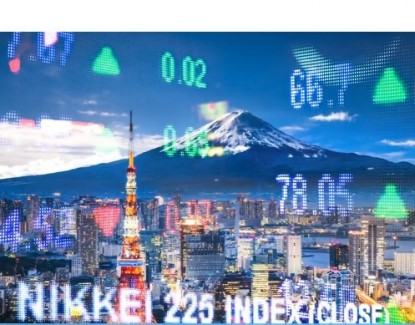Market Commentary and Fund Performance
Masa Takeda of Tokyo-based SPARX Asset Management Co., Ltd., sub-advisor to the Hennessy Japan Fund, shares his insights on the Japanese market and Fund performance.
-
 Masakazu Takeda, CFA, CMAPortfolio Manager
Masakazu Takeda, CFA, CMAPortfolio Manager
Fund Performance Review
In April, the Fund increased by 0.28% (HJPIX), underperforming its benchmark, the Russell/Nomura Total MarketTM Index, which rose by 0.71%.
The month’s positive performers among the Global Industry Classification Standard (GICS) sectors included shares of Industrials, Financials and Consumer Discretionary, while Information Technology and Materials detracted from the Fund’s performance.
Click here for full, standardized Fund performance.
Among the best performers were our investments in Mitsubishi Corporation, the largest trading company in Japan, Terumo Corporation, Japan’s largest medical device manufacturer, and Sony Group Corporation, a diversified consumer and professional electronics, gaming, entertainment and financial services conglomerate.
As for the laggards, Shin-Etsu Chemical Co., Ltd., Japan’s largest chemical company, Keyence Corporation, the supplier of factory automation related sensors, and Tokyo Electron, Ltd., a manufacturer of semiconductor equipment, were the largest detractors.
This month, the famed investor Warren Buffett came to Tokyo to pay a visit to Japan’s five major trading houses, which have grown into a major position in Berkshire Hathaway’s gigantic publicly traded equity portfolio in recent years.
Mr. Buffett apparently began to invest in these companies around 2018. Berkshire owns stakes in each of these companies now exceeding 5% of outstanding shares, a threshold over which a regulatory filing is required. Japanese stocks have become one of the largest foreign exposures within Berkshire’s investment portfolio.
On his initial investments in 2018, the valuations of these companies were in the mid-to-high single-digit range with above-average dividend yields and consistent share buybacks. The five companies have also been cash flow generative.
As a long-term admirer of this iconic American investor, it was a proud moment when we learned that his very first investment in Japan was a stock we had owned for a long time in our Fund, Mitsubishi Corporation. From time to time, we have touched upon Mitsubishi Corp. as an attractive investment for its track record of compounding per share net asset value at a high single to over 10% compounded annual growth rate (CAGR) over the past 20 years.
Despite this, Mitsubishi Corp. together with its peers always traded at value-stock-like multiples. This is primarily due to perceived over-dependence on natural commodity businesses and their widely diversified business portfolios contributing to conglomerate discounts. But their investments are not necessarily restricted to natural resources. In essence, Sogo Shosha, as they are dubbed, are investment companies.
In a CNBC interview, Mr. Buffett described these general trading houses as follows: “They were companies that I generally understood what they did. Somewhat similar to Berkshire in that they owned lots of different interests.” Then he went on to reveal his rationale behind this investment: “they were selling at what I felt was a ridiculous price, particularly the price compared to the interest rates prevailing at that time. I was confounded by the fact that we could buy into these companies and, in effect, have an earnings yield of maybe 14% or something like that with dividends that would grow, that they actually grew 70% during that time.”
Suddenly, Japanese media and sell-side strategists alike started to speculate on his next move. Which stocks would he be interested in acquiring in Japan? While there are many stock ideas being tossed around, no one knows for sure what is on Mr. Buffett’s mind right now. Our own hypothesis is that it could be Japan’s non-life insurance companies. And the Fund has been invested in them since last year. We have described these companies as “growth stocks in disguise” in our past investment letters. That is to say, if their mid-to-high single-digit earnings growth, sustainable share buybacks and high dividend yields are combined, their expected shareholder returns are comparable to “pure” growth names (i.e. around 10% per annum). Notwithstanding Mr. Buffett’s interest, we believe Japan’s non-life insurance companies are attractive investments.
After years of consolidation, Japan’s three non-life mega-insurance groups control nearly 90% of the domestic underwriting business today. This allows them to generate abundant cash flows. Thanks to the oligopolistic industry structure, they possess strong pricing power to protect their profitability from ongoing inflation. Furthermore, we believe they are sitting on large unrealized gains on what is commonly called “strategic equity holdings” collectively worth 5.8tn yen ($42.1bn) in total (as of the end of FY21. Source: YUHO), which has been liquidated annually and wisely used to create shareholders’ value. These aspects are very unique to Japanese insurance companies.1
One way these companies utilize the capital is making overseas acquisitions, particularly in the U.S. specialty insurance space. The U.S. is the largest insurance market in the world, more than 15 times the size of Japan (Source: MSAD annual report). Tokio Marine, for example, has made five large acquisitions since 2008. Today, its overseas contribution accounts for nearly half of their consolidated financial performance with a strong underwriting track record. We believe that Japanese insurers are growing businesses. One compelling reason for going overseas is the diversification of their underwriting portfolios. Japan is an archipelago prone to earthquakes and typhoons and is also a country with a high ownership of automobiles. As such, the bulk of insurance portfolios is made up of auto and fire insurance policies. As insurance is a business of risk management, overseas exposure in the specialty insurance category brings diversification effects, which should translate into lower equity risk premium moving forward. This is a major difference with other financial subsectors in Japan such as banks and life insurers. Banks generally benefit less from overseas expansion as interest rates around the world tend to move more or less the same way. Life insurers are considered to already have well-diversified portfolios within the domestic business domain given the granularity of insurance policies and the nature of underwriting risks (death benefits are actuarially determined to ensure the insurers’ financial stability).
When there are no sensible acquisition targets, the next thing these non-life insurers attend to is the shareholder return policy. When it comes to share buybacks and dividend payouts, these companies are in an excellent position. Share buybacks are only value-accretive when it is done at a share price deemed undervalued relative to the intrinsic value. On this point, these companies often trade at mid-to-high single-digit price to earnings (P/E) multiples based on adjusted net income. We believe the adjusted net income is a fair metric for J-GAAP (Japanese generally accepted accounting principles) based insurance companies to compare with IFRS (International Financial Reporting Standards) -based foreign insurers. It is calculated by adding back various provisions for insurance claims reserves as well as amortization of goodwill and other intangible assets, and valuation allowances to the consolidated GAAP accounting-based net profit.
This approximates the insurers’ cash-earnings and is widely used as a management key performance indicator. Effectively, in our opinion, their stocks offer an earnings yield of over 10%, similar to the trading houses that Mr. Buffett invested in.
In terms of dividend payment, all three groups have increased their dividend per share at a 10 year CAGR of between 10% and 18% and boost dividend yields of 3.5%-5.0% today, which is again similar to the trading companies.
Lastly, Mr. Buffett is an expert in the insurance business. Of course, the idea of Japanese insurance companies as Warren Buffett’s next target is all just conjecture.
Mr. Buffett could be looking at totally different names (for example, his next target could be an iron and steel company in Japan just like his past investment of Posco in Korea back in the 2000s) or he may not invest in Japan anymore. But his rationale for Japanese trading companies reinforces our optimism that the Fund’s positions in these insurance companies are sound investments.
Click here for a full listing of Holdings.
- In this article:
- Japan
- Japan Fund
1 These equity holdings are long-term shareholdings in their publicly-traded corporate clients and were mainly acquired during the 1960s solely for the purpose of promoting business relationships. According to the insurance companies, these holdings were often justified to win business. However, the reality is most business relationships are now forged based on merits, not the presence of the equity holdings. Today, the equity holdings still remain on their balance sheets. This has led to criticisms by the investor community as idle financial assets and there has long been call for their sales to put the proceeds to more productive use.
You might also like
-
 Portfolio Perspective
Portfolio Perspective
Japan FundJapan’s Evolving Investment Landscape in 2025
 Masakazu Takeda, CFA, CMAPortfolio Manager
Masakazu Takeda, CFA, CMAPortfolio Manager Angus Lee, CFAPortfolio Manager
Angus Lee, CFAPortfolio Manager Kohei MatsuiPortfolio ManagerRead the Commentary
Kohei MatsuiPortfolio ManagerRead the CommentaryIn the following commentary, the Hennessy Japan Fund Portfolio Managers summarized what most surprised them in 2024 about the Japanese market along with positive trends driving Japanese companies.
-
 Investment Idea
Investment IdeaCompelling Valuations in Japan
 Masakazu Takeda, CFA, CMAPortfolio Manager
Masakazu Takeda, CFA, CMAPortfolio Manager Tadahiro Fujimura, CFA, CMAPortfolio Manager
Tadahiro Fujimura, CFA, CMAPortfolio Manager Takenari Okumura, CMAPortfolio ManagerRead the Investment Idea
Takenari Okumura, CMAPortfolio ManagerRead the Investment IdeaJapanese equities are currently trading at compelling valuation levels compared to other developed equity markets around the world and relative to their own historical averages. We believe the Japanese market deserves a closer look.
-
 Investment Idea
Investment IdeaWhy Active Matters When Investing in Japan
 Masakazu Takeda, CFA, CMAPortfolio Manager
Masakazu Takeda, CFA, CMAPortfolio Manager Angus Lee, CFAPortfolio Manager
Angus Lee, CFAPortfolio Manager Kohei MatsuiPortfolio Manager
Kohei MatsuiPortfolio Manager Tadahiro Fujimura, CFA, CMAPortfolio Manager
Tadahiro Fujimura, CFA, CMAPortfolio Manager Takenari Okumura, CMAPortfolio ManagerRead the Investment Idea
Takenari Okumura, CMAPortfolio ManagerRead the Investment IdeaWhen investing in Japanese businesses, we believe it is imperative to select a manager who is immersed in the culture and can perform in-depth, company-specific research to build a concentrated portfolio of Japanese companies that can outperform a benchmark and weather volatility.
